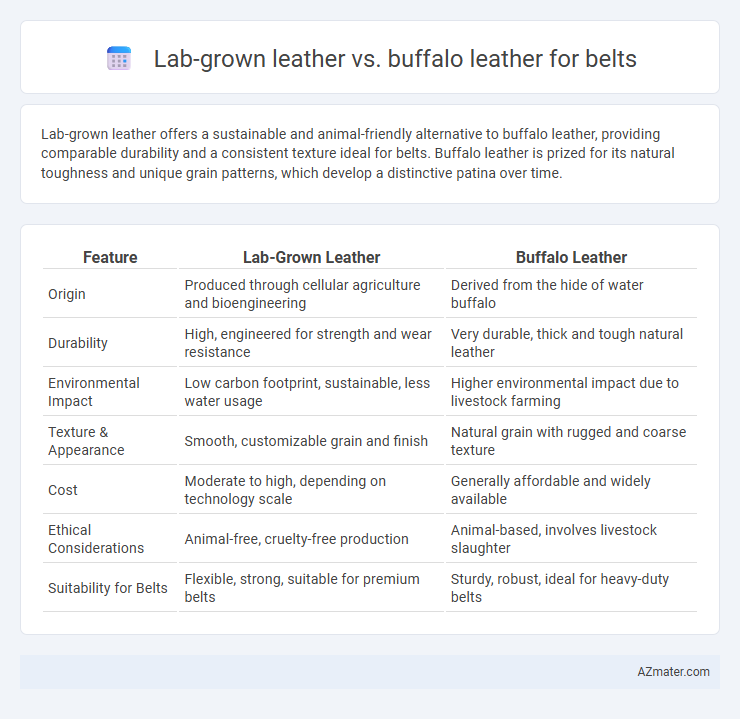Lab-grown leather offers a sustainable and animal-friendly alternative to buffalo leather, providing comparable durability and a consistent texture ideal for belts. Buffalo leather is prized for its natural toughness and unique grain patterns, which develop a distinctive patina over time.
Table of Comparison
| Feature | Lab-Grown Leather | Buffalo Leather |
|---|---|---|
| Origin | Produced through cellular agriculture and bioengineering | Derived from the hide of water buffalo |
| Durability | High, engineered for strength and wear resistance | Very durable, thick and tough natural leather |
| Environmental Impact | Low carbon footprint, sustainable, less water usage | Higher environmental impact due to livestock farming |
| Texture & Appearance | Smooth, customizable grain and finish | Natural grain with rugged and coarse texture |
| Cost | Moderate to high, depending on technology scale | Generally affordable and widely available |
| Ethical Considerations | Animal-free, cruelty-free production | Animal-based, involves livestock slaughter |
| Suitability for Belts | Flexible, strong, suitable for premium belts | Sturdy, robust, ideal for heavy-duty belts |
Introduction: Understanding Lab-Grown and Buffalo Leather
Lab-grown leather, crafted through innovative bioengineering techniques, mimics the texture and durability of traditional leather without animal involvement, presenting a sustainable alternative for belt manufacturing. Buffalo leather, harvested from water buffalo hides, is renowned for its toughness, grain texture, and natural resistance to wear, making it a popular choice in premium belt production. Comparing these materials reveals key differences in environmental impact, ethical considerations, longevity, and aesthetic qualities crucial for consumers seeking quality and sustainability in leather belts.
Material Composition: How Each Leather is Made
Lab-grown leather for belts is created through a biofabrication process where animal cells are cultured in a lab environment, producing collagen fibers that mimic natural leather's texture and strength without involving animal hides. Buffalo leather, derived from the hides of water buffalo, undergoes traditional tanning methods involving chemical treatments to convert rawhide into durable leather, characterized by its toughness and grain pattern. The material composition of lab-grown leather is primarily collagen-based with customizable properties, whereas buffalo leather consists of organic proteins and natural fats retained from the animal's skin, influencing its durability and appearance.
Sustainability and Environmental Impact
Lab-grown leather, produced through cellular agriculture, drastically reduces water usage by up to 90% and lowers carbon emissions compared to traditional buffalo leather, which involves intensive resource consumption in livestock farming. Buffalo leather production contributes to deforestation, methane emissions, and extensive land use, making it less sustainable over time. Choosing lab-grown leather for belts supports eco-friendly manufacturing practices by minimizing environmental degradation and promoting renewable material sources.
Durability: Which Leather Lasts Longer?
Lab-grown leather offers consistent durability with resistance to wear and environmental damage due to its engineered fibers, making it a strong candidate for long-lasting belts. Buffalo leather is known for its natural toughness, heavy grain, and high tensile strength that provide excellent abrasion resistance and longevity in belt applications. While buffalo leather can develop a beautiful patina over time, lab-grown leather maintains its structural integrity without cracking or fading, often resulting in comparable or superior lifespan under regular use.
Aesthetic Appeal and Texture Differences
Lab-grown leather offers a consistently smooth and uniform texture, often resembling premium buffalo leather but without natural irregularities. Buffalo leather exhibits a distinct grain pattern with a coarse, rugged texture that enhances its aesthetic appeal, making each belt unique. The choice between lab-grown and buffalo leather for belts centers on preference for either sleek, modern uniformity or natural, tactile depth.
Comfort and Wearability for Daily Use
Lab-grown leather offers enhanced comfort due to its consistent texture and flexibility, making it ideal for daily belts that require soft, break-in qualities. Buffalo leather, renowned for its durability and natural grain, provides superior wear resistance but can be stiffer initially, often requiring a longer break-in period. Both materials balance wearability and comfort, but lab-grown leather excels in uniform softness, while buffalo leather ensures robustness for everyday use.
Ethical Considerations: Animal Welfare and Alternatives
Lab-grown leather offers a cruelty-free alternative to traditional buffalo leather by eliminating animal slaughter and reducing the environmental footprint associated with livestock farming. Buffalo leather production involves ethical concerns tied to animal welfare, including the treatment and living conditions of the animals. Choosing lab-grown leather for belts supports sustainable fashion efforts and promotes animal rights by utilizing biotechnology to replicate genuine leather textures without harm to animals.
Cost Comparison: Price Points for Both Leathers
Lab-grown leather belts generally cost 20-40% more than traditional buffalo leather due to advanced manufacturing processes and limited mass production. Buffalo leather belts are priced between $30 to $70, offering affordability and durability, while lab-grown options range from $50 to $100, reflecting their eco-friendly appeal and innovative technology. Price disparities narrow as lab-grown leather technology scales, potentially making it more competitive with buffalo leather in the near future.
Maintenance and Care Requirements
Lab-grown leather demands less frequent conditioning and resists cracking or fading better than buffalo leather, making it low-maintenance for belts. Buffalo leather requires regular moisturizing with leather-specific conditioners to maintain its suppleness and prevent stiffness or drying over time. Both materials benefit from avoiding prolonged exposure to water and excessive heat, but buffalo leather is more sensitive to environmental damage, increasing care needs.
Future Trends in Leather Belt Manufacturing
Lab-grown leather offers a sustainable alternative to traditional buffalo leather, reducing environmental impact and enabling customizable textures ideal for belt manufacturing. Innovations in biotechnology and material science are driving the adoption of lab-grown leather, allowing brands to meet increasing consumer demand for ethical and eco-friendly products. While buffalo leather remains valued for its durability and natural aesthetic, the future of leather belt production leans towards integrating lab-grown options to balance performance with sustainability.

Infographic: Lab-grown leather vs Buffalo leather for Belt
 azmater.com
azmater.com